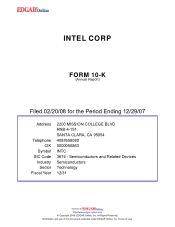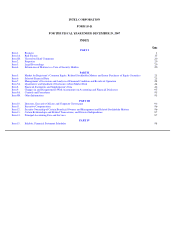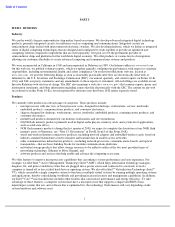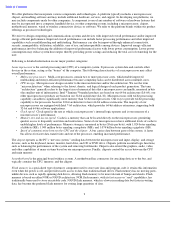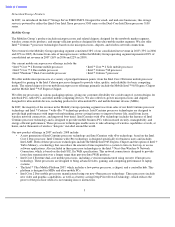Intel 2007 Annual Report Download - page 7
Download and view the complete annual report
Please find page 7 of the 2007 Intel annual report below. You can navigate through the pages in the report by either clicking on the pages listed below, or by using the keyword search tool below to find specific information within the annual report.
Table of Contents
We offer platforms that incorporate various components and technologies. A platform typically includes a microprocessor,
chipset, and enabling software and may include additional hardware, services, and support. In developing our platforms, we
may include components made by other companies. A component is one of any number of software or hardware features that
may be incorporated into a computer, handheld device, or other computing system, including a microprocessor, chipset,
motherboard, memory, wired or wireless connectivity device, or software. We refer to the platform brands within our product
offerings as processor technologies.
We strive to design computing and communications systems and devices with improved overall performance and/or improved
energy-efficient performance. Improved overall performance can include faster processing performance and other improved
capabilities such as multithreading and multitasking. Performance can also be improved through enhanced connectivity,
security, manageability, utilization, reliability, ease of use, and interoperability among devices. Improved energy-efficient
performance involves balancing the addition of improved performance factors with lower power consumption. Lower power
consumption may reduce system heat output, thereby providing power savings and reducing the total cost of ownership for the
user.
Following is detailed information on our major product categories:
A microprocessor is the central processing unit (CPU) of a computer system. It processes system data and controls other
devices in the system, acting as the “brains” of the computer. The following characteristics of a microprocessor may affect
overall performance:
The chipset operates as the PC’s “nervous system,” sending data between the microprocessor and input, display, and storage
devices, such as the keyboard, mouse, monitor, hard drive, and CD or DVD drive. Chipsets perform essential logic functions,
such as balancing the performance of the system and removing bottlenecks. Chipsets also extend the graphics, audio, video,
and other capabilities of many systems based on our microprocessors. Finally, chipsets control the access between the CPU
and main memory.
A motherboard is the principal board within a system. A motherboard has connectors for attaching devices to the bus, and
typically contains the CPU, memory, and the chipset.
Flash memory
is a specialized type of memory component used to store user data and program code; it retains this information
even when the power is off, and provides faster access to data than traditional hard drives. Flash memory has no moving parts,
unlike devices such as rapidly spinning disk drives, allowing flash memory to be more tolerant of bumps and shocks. Flash
memory is based on either NOR or NAND architecture. NOR flash memory, with its fast access or “read” capabilities, has
traditionally been used to store executable code. NAND flash memory, which is slower in reading data but faster in writing
data, has become the preferred flash memory for storing large quantities of data.
2
•
Multi
-core processors. Multi-core processors contain two or more processor cores, which enable improved
multitasking and energy
-
efficient performance because computing tasks can be distributed across multiple cores.
• CPU design. Microprocessor design can refer to the microarchitecture and/or the architecture. We use the term
“microarchitecture” when referring to the layout, density, and logical design of each product generation. The term
“architecture” generally refers to the largest size of numerical data that a microprocessor can handle, measured in bits
(the smallest unit of information). Intel
®
Itanium
®
branded products are based on our 64-bit architecture (IA-64); our
other microprocessor products are based on our 32-bit architecture (IA-32). Microprocessors with 64-bit processing
capability can address significantly more memory than 32-bit microprocessors. One way to provide 64-bit processing
capability is for processors based on 32-bit architecture to have 64-bit address extensions. The majority of our
microprocessors are equipped with Intel
®
64 architecture, which provides 64-bit address extensions, supporting both
32
-
bit and 64
-
bit software applications.
• Clock speed. Clock speed is the rate at which a microprocessor’s internal logic operates and is one measure of a
microprocessor
’
s performance.
•
Memory size and access speed.
Cache is a memory that can be located directly on the microprocessor, permitting
quicker access to frequently used data and instructions. Some of our microprocessors have additional levels of cache to
enable higher levels of performance. Memory storage is measured in bytes (8 bits per byte), with 1,024 bytes equaling
a kilobyte (KB), 1.049 million bytes equaling a megabyte (MB), and 1.074 billion bytes equaling a gigabyte (GB).
• Speed of communication between the CPU and the chipset. A bus carries data between parts of the system. A faster
bus allows for faster data transfer into and out of the processor, enabling increased performance.

